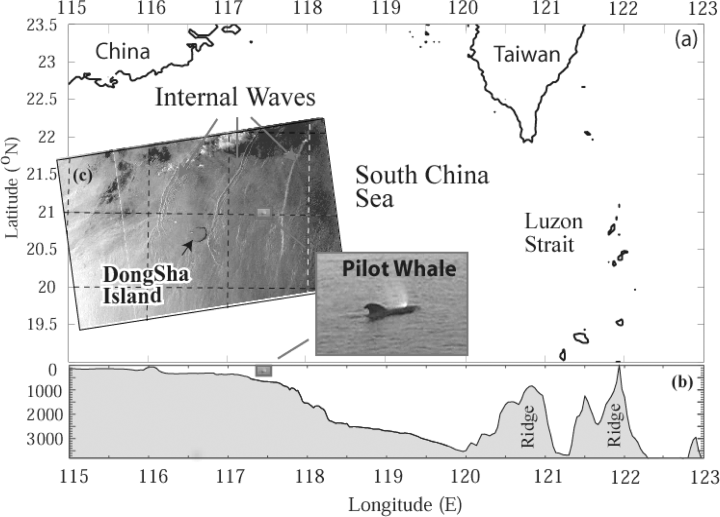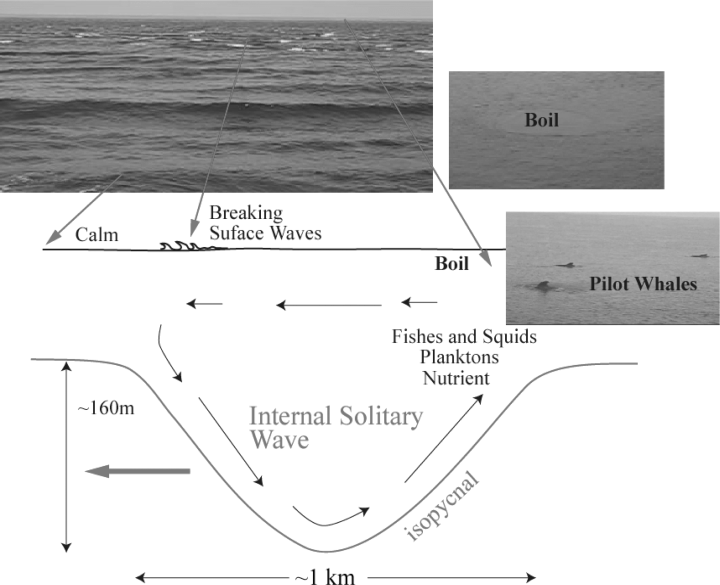PILOT WHALES FOLLOW INTERNAL SOLITARY WAVES IN THE SOUTH CHINA SEA
To forage effectively, cetaceans must find aggregated prey in the open ocean and coastal seas. Recent studies indicate that whales and dolphins may exploit prey aggregations associated with predictable but ephemeral meso- to fine-scale ocean features, such as upwellings, fronts, and eddies (e.g., Griffin 1999, Biggs et al. 2000, Mendes et al. 2002). For example, Johnston et al. (2005) demonstrated that harbor porpoises (Phocoena phocoena) forage in focal regions of the Bay of Fundy where localized fronts form during flood tides. These results support the hypothesis that odontocete prey can become aggregated in regions of enhanced relative vorticity, making important the identification and prediction of ocean dynamics that create such features.
In the South China Sea, large-amplitude internal waves occur in Luzon Strait, between Taiwan and the Philippine Islands, during spring tides (Lien et al. 2005, Ramp et al. 2005). These waves shoal near Dongsha plateau and force nutrients and plankton into the upper ocean. One of us (RCL) investigated the physical features of internal waves in the South China Sea in spring of 2005. Observations were made along latitude 21°N between longitudes 118°E and 116.5°E and, on 28 and 29 April, solitary internal waves having a vertical amplitude greater than 150 m were measured at ∼117.5°E (Fig. 1). The waves propagated westward at a speed of 1–2 m/s in water ∼600 m deep. All observations were made during periods of weak winds, such that the sea surface was calm prior to the arrival of the internal waves. The strong convergence of horizontal current in the front portion of the waves caused an accumulation of breaking waves at the surface (Fig. 2). Conspicuous surface boils were created at the rear of the internal waves, presumably caused by strong upwelling, to 0.5 m/s, speeds capable of bringing up nutrients and zooplankton and potentially entraining fishes and squids.

Map of South China Sea, (a) bathymetry along 21° N, (b) an illustration of satellite image showing the surface signature of internal solitary waves (c: note gray arrows). The pilot whale photo, taken on 28 April 2005 NE on the Dongsha plateau, is inserted on the bathymetry plot and satellite image to show the approximate observation location.

Snapshots of varying sea-surface conditions associated with internal waves coupled to a schematic diagram showing the spatial scale and currents associated with an observed wave. The U shape depicts the deformation of an isopycnal, a zone of strong density stratification that commonly occurs at 100–150 m depth in the study area. Internal waves observed near Dongsha Island in the South China Sea were roughly 1 km long, had amplitudes greater than 150 m, with maximum horizontal current of 2 m/s in the center of the wave. Strong downwelling in the front portion of the internal wave creates breaking surface waves; upwelling in the rear portion of the wave, where the pilot whales were seen, creates surface boils and may entrain fishes, squids, plankton, and nutrients.
During both days, a pod of at least six short-finned pilot whales (Globicephala macrorhynchus) was observed following the internal waves. The whales were identified by their distinctive bulbous forehead and falcate dorsal fins. The whales swam within the 1-km bounds of the internal waves, sometimes in chorus-line formation, following the trough region where the waves generate upwelling (Fig. 2). Short-finned pilot whales are common in tropical and warm temperate waters worldwide (Leatherwood and Reeves 1983), although distribution and movements in the South China Sea are not well known (Yang et al. 1999, Zhou et al. 1995). Pilot whales often travel in groups ranging from a few, as seen during these observations, to several hundreds. Although there was no opportunity to determine dive times or collect prey samples, in general, pilot whales feed on various species of fishes and squids. Prey preferences in the South China Sea are unknown.
To our knowledge, this is the first report of cetaceans associated with internal waves. While we cannot confirm that the pilot whales were actually using the feature to aggregate prey, the physical forces associated with upwelling at the boil's margins could indeed entrain small fish and squid. We speculate that prey availability for pilot whales in the South China Sea is influenced by the aggregative properties of internal waves generated by spring tides and, as in Johnston et al. (2005), suggest that at fine-scales, cetacean foraging habitats should be described by modeling interactions between physical features and time-variant phenomena such as winds, currents, and tides.
Acknowledgments
We thank Dr. Tang and the graduate students of National Taiwan University, Dr. Yang of Chinese Naval Academy, and crews of R/V Oceanic Research III of Taiwan for assisting the field measurements. The project is funded by the United States Office of Naval Research and the National Science Council of Taiwan.




